Ireland - rents rising fast, house price inflation slowing
 After double-digit price rises last year, Irish house prices slowed to single-digit increases during the second half of 2015. The national residential property price index rose by 6.54% (6.75% inflation-adjusted) during the year to November 2015, compared to the annual rise of 16.19% during the same period last year, according to Central Statistics Office (CSO) Ireland.
After double-digit price rises last year, Irish house prices slowed to single-digit increases during the second half of 2015. The national residential property price index rose by 6.54% (6.75% inflation-adjusted) during the year to November 2015, compared to the annual rise of 16.19% during the same period last year, according to Central Statistics Office (CSO) Ireland.
Based on the latest Daft.ie report, average transaction prices were up by 5.6% during the year to September 2015.
In Dublin, Ireland's capital city, house prices slowed even more. Dublin's residential property price index rose by 3.35% (3.55% inflation-adjusted) during the year to November 2015, way below last year's 22.40% (22.28% inflation-adjusted) y-o-y increase.
House prices were pushed in 2013-4 by Ireland's strong economic growth. The housing market then slowed, especially in Dublin, largely because of central bank measures in January 2015 which limited loan-to-value ratios on houses priced over €220,000 and on 2nd purchases to 80%, and 70% on buy-to-let purchases. Loans for private dwelling homes were also limited to 3.5 times gross income.
- In Dublin City Centre, the average asking price rose by 5.4% to €247,803 (US$ 271,270), during the year to Q3 2015.
- North County Dublin's average asking price rose by 4% y-o-y to €260,512 (US$ 285,183).
- West County Dublin's average asking price rose by 3.3% y-o-y to €264,957 (US$ 290,049).
- South County Dublin's average asking price rose by 1.6% y-o-y to €520,451 (US$ 569,738).
Outside Dublin, average residential prices rose by 9.60% (9.82% inflation-adjusted) during the year to November 2015, according to the CSO Ireland. Based on Daft.ie's figures:
- In Carlow (located in Leinster, eastern Ireland), the average residential asking price was €143,967 (US$ 157,601), a 6.9% y-o-y increase to Q3 2015.
- In Cork County (located in Munster, in Ireland’s south), the average asking price was €174,951 (US$ 191,519), up by 15.9% y-o-y to Q3 2015.
- In Galway County (located in Connacht, Ireland’s western region), the average asking price was €152,209 (US$ 166,623), a 13.2% rise during the year to Q3 2015.
- In Waterford County, the average asking price was €179,590 (US$ 196,597), up by 15.8% y-o-y to Q3 2015.
- In Limerick County, the average asking price was €149,613 (US$ 163,781), a 10% y-o-y increase to Q3 2015.
- In Monaghan (located in Ulster, in the Republic of Ireland's north), the average asking price was €135,493 (US$ 148,324), a 10.9% y-o-y increase to Q3 2015.
Apartments rose by 7.36% during the year to November 2015 (7.57% inflation-adjusted); houses rose by 6.52% y-o-y (6.73% inflation-adjusted).
ANNUAL HOUSE PRICE CHANGE, NOVEMBER 2015 |
||||||
| HOUSES | APARTMENTS | ALL RESIDENTIAL | ||||
| Nominal | Real | Nominal | Real | Nominal | Real | |
| Ireland | 6.52 | 6.73 | 7.36 | 7.57 | 6.54 | 6.75 |
| Dublin | 3.05 | 3.25 | 6.06 | 6.27 | 3.35 | 3.55 |
| Rest of Ireland | 9.51 | 9.72 | --- | --- | 9.60 | 9.82 |
| Source: Central Statistics Office Ireland | ||||||
Ireland's big boom was followed by Europe's biggest price declines
From 1997 to 2007 Ireland experienced a massive house price boom, with average used home prices up 268%, and new house prices up 216%. Ireland’s decade-long house price boom was one of the longest and biggest in Europe.
HOUSE PRICE CHANGE 1996 - 2006 |
||
| NEW | SECOND-HAND | |
| IRELAND | 216% | 268% |
| Dublin | 241% | 278% |
| Cork | 239% | 316% |
| Galway | 174% | 242% |
| Limerick | 216% | 250% |
| Waterford | 219% | 292% |
| Others | 213% | 263% |
| Source: DoECLG | ||
The Irish housing boom was fuelled by strong economic growth, immigration, and generous tax incentives and grants from the government, creating a virtuous cycle of economic growth and house price increases. Low interest rates and loose credit conditions provided financing.
When the bubble burst in 2008, it was Europe's biggest property bust. The downturn began in 2006 and 2007, when interest rate hikes left many borrowers in difficulty, causing a housing market crash. The 2006-2007 U.S. subprime mortgage crisis added to the downturn.
Ireland's house prices fell by an average of 53% from the peak, compared to the typical OECD fall of 23%:
- In 2008, the residential property price index fell 12.4% (-13.3% inflation-adjusted) from a year earlier.
- In 2009, house prices fell 18.6% (-14.4% inflation-adjusted) from a year earlier.
- In 2010, house prices fell 10.5% (-11.7% inflation-adjusted) from a year earlier.
- In 2011, house prices plunged 16.7% (-18.7% inflation-adjusted) from a year earlier.
- In 2012, house prices dropped 4.5% (-5.6% inflation-adjusted) from a year earlier.
The Irish housing market started to recover in 2013, with house prices rising by 6.4% (6.2% inflation-adjusted). The dramatic house price surge in 2014 was mainly due to the recovery of the Irish economy, which expanded by 5.2% in 2014, up from growth of only 1.4% in 2013 and 0.2% in 2012. The economy is believed to have grown by 5.8% in 2015, with 4.7% growth projected in 2016, according to the Central Bank of Ireland.
Fears of another bubble in Dublin
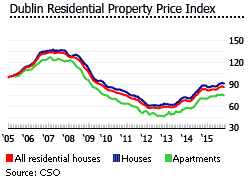
Another property bubble is already here, say some Cassandras.
"This property bubble being developed by vested interests needs bursting and bursting sooner rather than later," says David Hall, the founder of the Irish Mortgage Holders Organisation (IMHO). "The financial system owes a gratitude to the Irish citizen for keeping it afloat and now it needs to back off irresponsible promoting of a property bubble, which could land many citizens in deep financial trouble again."
Others argue that the problem is not speculation - but a supply shortage, with high VAT rates on new homes and other taxes discouraging new home building.
"The reality is that the effective cost of bringing a new unit to market in most of Ireland is higher than the achievable sales price at this time,” said Philip O´Sullivan of Investec Ireland.
“This is why completions are running at about a quarter of their long-term average, while many of the units finished in the recent past involved the completion of semi-built developments from the bubble era."
The government is under pressure to increase supply, especially in the capital. “Boosting supply is ultimately the key factor for sustainable price growth in the long-run,” said John McCartney of Savills Ireland.
In an attempt to prevent another housing bubble from happening, the central bank implemented new rules January 2015.
The new measures seem to be effective in toning down the property price hikes, particularly in Dublin. “This is confirmed by the slowdown in price dynamics and evidence from the Central Bank survey of the house price expectations of property market professionals,” wrote Gabriel Fagan, an economist at the Central Bank of Ireland. However, Fagan clarified that it is still too early to tell the effectiveness of these measures, and the earliest date for an initial assessment on the measures' impact would be in mid-2016.
Interest rates are still relatively low
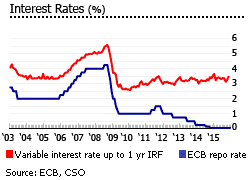
The European Central Bank (ECB)’s refinancing rate remained at 0.05% in November 2015, after being cut by 10 basis points in September 2014.
Mortgage rates in October 2015:
- The variable interest rate for initial rate fixation (IRF) of up to 1 year was 3.46%, slightly up on 3.36% last year.
- The mortgage rate for IRF of over 1 year was 3.75%, down from 4.32% the previous year.
Interest rates on outstanding mortgages in Ireland have typically reflected movements in the ECB rate. However, during the past three years these rates have diverged.
Contracting mortgage market
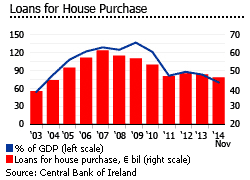
Ireland's mortgage market is still shrinking. Residential mortgage lending fell to 41.4% of GDP in 2014, from 46.4% of GDP in 2013 - way below the peak of 65% of GDP in 2009. Loans outstanding for house purchase fell by 5.32% to €76.54 billion (US$ 83.79 billion) during the year to Q3 2015, according to the Central Bank of Ireland.
The mortgage market is expected to shrink further as the central bank’s lending cap takes effect.
On January 27, 2015, the central bank introduced new regulations further limited mortgage lending in order to "increase the resilience of the banking and household sectors to the property market and to reduce the risk of bank credit and house price spirals from developing in the future". Some of the new measures include:
- Loan to Value (LTV) limits for principal dwelling houses (PDH):
- 80% LTV limit on PDH mortgages of non-first time buyers
- Maximum LTV of 90% on properties worth up to €220,000 (US$ 240,834) for first time buyers. If the value exceeds €220,000, the 90% LTV applies only to the first €220,000 value of the property, and the exceeding amount will have an 80% LTV limit.
- The cumulative monetary value of PDH mortgages that violate these limits should not go beyond 15% of the euro value of all PDH loans on an annual basis
- LTV for Buy to Let mortgages (BLTs):
- 70% LTV limit on BTL mortgages
- The limit can go beyond by only up to 10% of the euro value of all non PDH mortgages on an annual basis
- Loan to Income (LTI) for PDH mortgages:
- A limit of 3.5 times loan to gross income on PDH mortgage loans
- The limit should not extend by over 20% of the euro value of all PDH mortgage loans during an annual period
‘We have carefully considered all feedback received through the consultation process. As far as the LTV limits are concerned, we are retaining the basic 80 per cent LTV limit for owner-occupier loans and 70 per cent for buy-to-lets with the proportionate allowances already announced. At the cost of some additional complexity, but without compromising the overall effectiveness of the measures, we are increasing the limit for first-time buyers of lower-cost houses," according to Central Bank of Ireland Governor Patrick Honohan.
Rents rising fast, fewer rental properties on the market

The housing crash initially resulted in a huge expansion of the number of rental properties on the market, which rose dramatically to more than 23,400 in August 2009, from only 6,200 units in August 2007. By November 2015 the number was back down to just over 4,000 properties, the lowest level recorded by Daft.ie since the beginning of their data series a decade ago.
In Dublin, only 1,600 properties were available for rent.
Ireland's rent index surged 9.6% during the year to October 2015 to €964 (US$ 1,055) per month between June and September 2015. The recent quarter (Q3 2015) marked the highest three-month jump in rents since 2007, with rents up 3.2% between June and September.
In the country's capital Dublin, rents were only just 2.5% lower than their peak levels.
- In Dublin City Centre, the average rent was €1,408 (US$ 1,541), up by 9.3% during the year to Q3 2015.
- In South County Dublin, the average rent increased by 7.2% y-o-y to €1,604 (US$ 1,756).
- In South Dublin City, the average rent rose by 7.9% y-o-y to €1,520 (US$ 1,664).
- In West County Dublin, the average rent was up by 10.6% y-o-y to €1,243 (US$ 1,361).
- In North County Dublin, the average rent rose by 11.1% y-o-y to €1,178 (US$ 1,290).
- In North Dublin City, the average rent increased by 9.3% y-o-y to €1,310 (US$ 1,434).
Rent increases also rose rapidly outside Dublin, but rents are still well below peak levels, according to Daft.ie:
- In Cork City, average rents were up by 13.5% y-o-y to €950 (US$ 1,040).
- In Galway City, average rents rose by 12.2% y-o-y to €868 (US$ 950).
- In Limerick City, average rents increased by 11.4% y-o-y to €761 (US$ 833).
- In Waterford City, average rents rose by 9.6% y-o-y to €661 (US$ 724).
Rental yields have risen across the country. According to Daft.ie. in Q3 2015:
- Dublin centre gross rental yields range from 2.7% to 10.1% depending on area and property type.
- West County Dublin gross rental yields range from 3.3% to 7.9%
- North County Dublin yields range from from 3.3% to 7.7%.
- South County Dublin yields rang from 2.4% to 5.6%
- Cork City and Galway City yields range from 2.9% to 8.5%.
- Limerick City gross rental yields range from 3.4% to 10%.
- Waterford City gross rental yields range from 3.6% to 10.5%.
House building is recuperating too slowly
Dwelling completions rose by 14.3% (to 10,052 units) during the first ten months of 2015, from the same period last year.
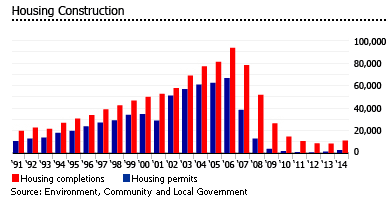
During the boom, completions tripled to 93,000 units in 2006, up from 30,000 units in 1995. However, by 2011 completions had fallen to only 10,480 units. The decline continued for two more years, with only 8,488 dwelling completions in 2012, and 8,301 units in 2013.
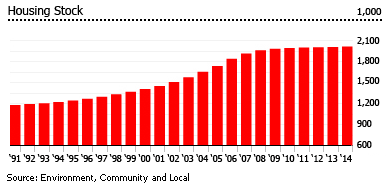
In 2014, completions rose by 32.7% to 11,016 units. The country's total housing stock was about 2,014,000 units in 2014, according to the Environment, Community and Local Government.
Positive outlook for 2016
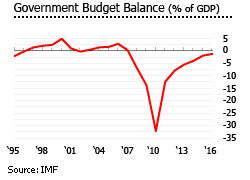
In Q3 2015, the country's economy posted 7% annual growth, with GDP rising by 1.4% during the quarter. During the whole year 2015, the Irish economy is believed to have expanded by 5.8%. Growth is expected to be somewhat slower at 4.7% in 2016, according to the central bank.
For three consecutive months the country has suffered from deflation, with consumer prices declining by 0.3% during the year to November 2015, according to Central Statistics Office (CSO) Ireland.
Unemployment stood at 8.9% in November 2015, down from 10.4% in November 2014, and lower than the 13.6% average from 2009 to 2013. Ireland's average unemployment rate of 4.4% between 2000 and 2007.
Ireland's economy now strong

Ireland's economy has been on an unusual journey over the past 5 years.
Ireland had the euro zone’s highest budget deficit in 2010, at 31.2% of GDP. In November 2010 it had no choice but to seek a €67.5 billion ($82 billion) bailout from the European Union (EU) and the International Monetary Fund (IMF). In exchange, Ireland committed to a harsh austerity program.
The country spent around €80 billion to establish the National Asset Management Agency (NAMA) to buy toxic loans, primarily to improve the availability of credit to the Irish economy, and to remove non-performing loans from bank balance sheets.
In June 2012, 60.29% of Irish voters agreed to the European fiscal compact of May 31, 2012, allowing Ireland to access to the European Stability Mechanism, a €500 billion ($618 billion) bailout fund.
By 2011 the Irish budget deficit had fallen to 12.5%, and to 8% in 2012, comfortably within the 8.6% target set by Ireland’s international creditors: the EU, ECB and IMF. The budget deficit declined again to 5.7% of GDP in 2013. At end-2013 Ireland became the first country to exit the eurozone bailout programme.
In 2014, the budget deficit shrunk to 3.9% of GDP. In December 2015, the finance ministry slashed their budget deficit forecast for 2015 to 1.7% from an earlier prediction of 2.1%. The reduction was due to the country's economic growth and the surge of corporation tax payments, according to Finance Minister Michael Noonan. "For 2016 we were pitching for 1.2, but ... it would be a safe assumption to take 0.4 off that as well. That would be 0.8, 0.7 percent," said Noonan.
Upcoming general elections
The Irish general election must be held by April 8, 2016. The 158 members of Dáil Éireann (Irish parliament) then elected will then choose a Taoiseach (prime minister).
Ireland's current Taoiseach is Enda Kenny, who took office in March 2011. Kenny belongs to the Fine Gael party, which dominated the 2011 elections in terms of seats won, and has since ruled in coalition with the Labour Party (which is its usual political partner). The differences between the two major Irish political parties (Fine Gael and Fianna Fail) do not follow a leftist-rightist cleavage, but reflect long-standing differences within the nationalist tradition.